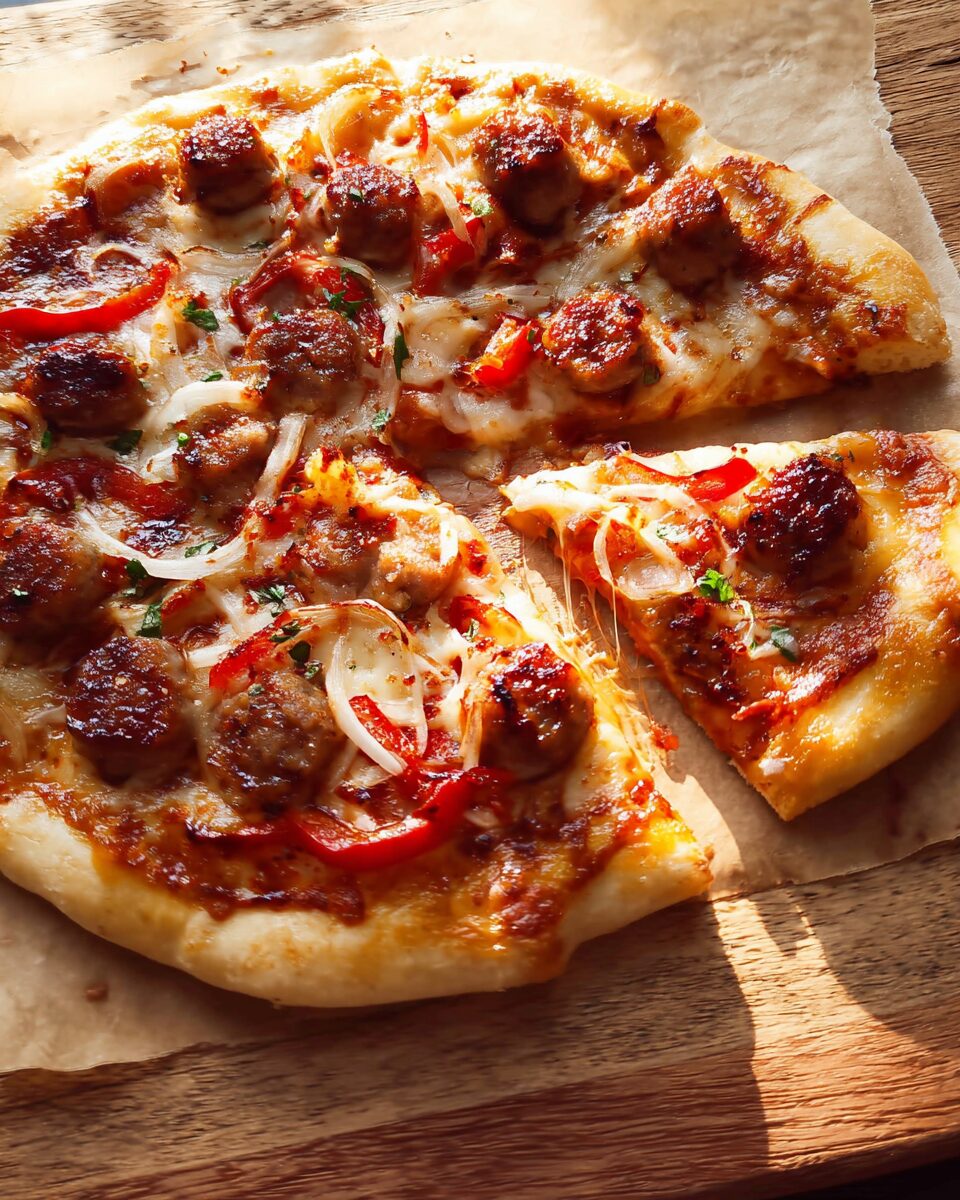This sausage pizza is everything you want in a comforting, cheesy meal. The crispy golden crust and the savory, juicy sausage come together perfectly with the melting mozzarella cheese to make every bite irresistible.
With just the right balance of spices and ingredients, this homemade pizza is bound to be a crowd-pleaser for family dinners, weekend gatherings, or a simple weeknight treat. It’s quick, easy to make, and customizable to suit your taste—whether you like it spicy with red pepper flakes or prefer it mild. Either way, you’re in for a delicious experience!
Full Recipe:
-
1 pizza dough (store-bought or homemade)
-
1 tablespoon olive oil
-
1/2 pound Italian sausage, crumbled
-
1/2 cup onion, thinly sliced
-
1/2 teaspoon red pepper flakes (optional)
-
1/2 teaspoon garlic powder
-
1/2 cup pizza sauce
-
2 cups shredded mozzarella cheese
-
1/2 cup shredded Parmesan cheese
-
1 tablespoon fresh basil, chopped
-
Salt and pepper to taste
Directions:
-
Preheat oven to 475°F (245°C).
-
Roll out pizza dough on a lightly floured surface to your desired size.
-
Heat olive oil in a skillet over medium heat. Add crumbled Italian sausage and cook for 5-7 minutes, or until browned. Remove from heat and set aside.
-
Brush olive oil on the pizza dough to create a golden crust. Spread pizza sauce evenly over the dough.
-
Sprinkle garlic powder, red pepper flakes, and a pinch of salt and pepper over the sauce.
-
Add a layer of shredded mozzarella cheese, followed by crumbled sausage and sliced onions.
-
Top with Parmesan cheese and bake for 12-15 minutes, or until the crust is golden and cheese is bubbly.
-
Remove from oven and sprinkle with fresh basil. Slice and serve!
Prep Time: 10 minutes | Cooking Time: 15 minutes | Total Time: 25 minutes
Kcal: 350 kcal | Servings: 4 servings
History and Origin
The history of sausage pizza is deeply intertwined with the origins of pizza itself. Pizza, as we know it today, hails from Naples, Italy, where it first emerged as a simple flatbread topped with fresh ingredients. The combination of sausage and pizza became popular as people began adding various types of meat to their pizzas, making them heartier and more filling. Sausage, with its rich and flavorful profile, quickly became a go-to topping for pizza lovers worldwide.
While sausage pizza is widely enjoyed across the globe, the exact origins of sausage as a topping can be traced to Italian cuisine, where sausage is a beloved ingredient in many dishes. In Italy, sausage is often made from pork, seasoned with a variety of spices such as fennel, garlic, and red pepper flakes. The spicy and savory nature of the sausage complements the rich mozzarella and tangy tomato sauce, making it the ideal addition to any pizza.
Pizza with sausage spread in popularity throughout the United States in the mid-20th century, where regional variations began to emerge. In places like Chicago, sausage is often layered in thick slices, while in New York, it’s typically crumbled over the pizza. The variations are endless, but what remains consistent is the universally beloved combination of sausage and cheese.
Variations and Adaptations
One of the best things about sausage pizza is its adaptability. While the classic sausage pizza combines Italian sausage, cheese, and tomato sauce, there are endless ways to make it your own. Below are a few variations that reflect the diverse ways this dish has evolved across regions and cultures:
-
Spicy Sausage Pizza: For those who enjoy a little heat, adding spicy Italian sausage or a sprinkle of red pepper flakes will kick up the flavor. Some even opt for chorizo for a more distinct, smoky flavor.
-
Vegetarian Sausage Pizza: In response to dietary preferences, many have turned to vegetarian or plant-based sausages. These alternatives mimic the texture and flavor of traditional sausage without the meat, offering a delicious and satisfying pizza for vegetarians and vegans alike.
-
Breakfast Sausage Pizza: A fun twist for brunch or breakfast, you can use breakfast sausage and add scrambled eggs and cheese for a hearty, morning-inspired pizza.
-
Sweet and Savory Sausage Pizza: Some regions embrace a sweeter approach to sausage pizza. Adding pineapple or caramelized onions can provide a beautiful contrast to the savory sausage and cheese, resulting in a more complex and exciting flavor profile.
-
Regional Varieties: In Chicago, where deep-dish pizza reigns supreme, sausage is often used in the form of thick slices or chunky crumbles, packed into a buttery, thick crust. In contrast, New York-style pizza tends to feature thin, crispy crusts with crumbled sausage sprinkled on top.
Nutritional Information
Sausage pizza, like most comfort foods, is indulgent, but it can be part of a balanced diet when enjoyed in moderation. Here’s a breakdown of the nutritional components you can expect from a slice of traditional sausage pizza:
-
Calories: A typical slice of sausage pizza can range from 300 to 400 calories, depending on the size and thickness of the crust, the amount of sausage used, and the type of cheese.
-
Macronutrients:
-
Protein: Thanks to the sausage and cheese, sausage pizza is a good source of protein, with approximately 12–15 grams per slice.
-
Fat: This pizza is also relatively high in fat due to the cheese and sausage, typically around 15–20 grams per slice. Opting for leaner sausage or reduced-fat cheese can help lower the fat content if desired.
-
Carbohydrates: The crust, often made from refined flour, contributes the majority of the carbs in this dish. Expect around 30–35 grams of carbs per slice.
-
Fiber: Pizza dough is low in fiber, though adding vegetables like bell peppers or spinach can increase the fiber content.
-
-
Micronutrients:
-
Calcium: The mozzarella cheese provides a good amount of calcium, essential for bone health.
-
Iron: The sausage contributes some iron, which is essential for healthy red blood cells.
-
Vitamins A and C: If you add toppings like bell peppers, onions, or tomatoes, you can increase the vitamin A and C content of your pizza.
-
While sausage pizza can be calorie-dense, it also offers a satisfying mix of protein, fats, and carbs. Choosing whole-grain crusts, leaner sausages, or adding more vegetables can improve the nutritional profile of the pizza.
Serving Suggestions and Pairings
Sausage pizza is a versatile dish that pairs beautifully with a wide range of accompaniments. Here are a few ideas for serving your sausage pizza to make the meal even more enjoyable:
-
Salads: Pair your sausage pizza with a fresh, crisp salad to balance out the richness. A simple arugula salad with lemon vinaigrette or a classic Caesar salad works wonders.
-
Beverages:
-
Wine: A robust red wine like Chianti or Cabernet Sauvignon complements the savory flavors of sausage pizza. The acidity in the wine cuts through the richness of the cheese and sausage, providing a perfect pairing.
-
Beer: If you’re a fan of beer, go for an amber ale, a pilsner, or even a hoppy IPA. The bitterness in beer contrasts nicely with the fat in the pizza.
-
Non-Alcoholic: For a non-alcoholic option, try sparkling water with a splash of lemon or a refreshing iced tea.
-
-
Dips: Many people enjoy dipping their pizza in sauces like garlic butter, ranch dressing, or a tangy marinara. These can be great for adding an extra layer of flavor to each bite.
-
Appetizers: Serve your pizza alongside appetizers such as garlic knots, bruschetta, or mozzarella sticks for a more indulgent meal.
Tips and Tricks for Success
-
Use a Pizza Stone: For the crispiest crust, use a pizza stone. Preheat the stone in the oven before placing the pizza on it. This mimics the effect of a brick oven, ensuring a golden, crispy base.
-
Don’t Overload the Toppings: While it’s tempting to add extra sausage, too many toppings can make the pizza soggy. Stick to a balanced amount of sausage and cheese for the best results.
-
Watch the Oven Temperature: Baking the pizza at a high temperature, typically 475°F (245°C), helps the crust bake quickly and evenly. Keep an eye on it to avoid burning the toppings while ensuring the crust is crispy.
-
Fresh Ingredients Matter: Use fresh, high-quality sausage and mozzarella for the best flavor. The freshness of these ingredients can really elevate the taste of your pizza.
-
Experiment with Homemade Dough: While store-bought pizza dough is convenient, nothing beats homemade dough. If you have the time, try making your dough for an even fresher, more satisfying pizza.
Potential Health Benefits
Though sausage pizza is considered indulgent, the ingredients do provide some health benefits. The mozzarella cheese is a good source of calcium and protein, both important for bone and muscle health. The sausage, depending on the type, can be rich in iron, while the tomato sauce provides antioxidants like lycopene, which may help reduce inflammation and promote heart health.
If you opt for a whole grain pizza crust or add a variety of vegetables to your pizza, you’ll increase the fiber and vitamin content, which can support digestion and overall health. Additionally, making your pizza with lean sausage or plant-based alternatives can reduce the saturated fat content, making it a healthier option without sacrificing flavor.
Conclusion
Sausage pizza is a dish that continues to be loved by people of all ages, thanks to its delicious combination of flavors and versatility. Whether you prefer it spicy, sweet, or loaded with vegetables, this pizza can easily become a weeknight staple or a show-stopping dish for a dinner party. By following a few simple tips, you can create a pizza that rivals the best pizzerias, while still making it your own. So, preheat your oven, gather your ingredients, and enjoy this ultimate comfort food that’s sure to bring joy to any table.





